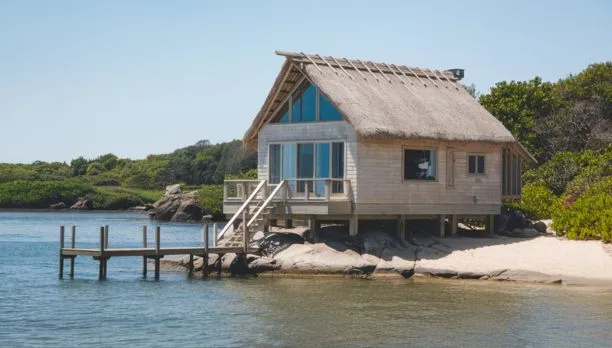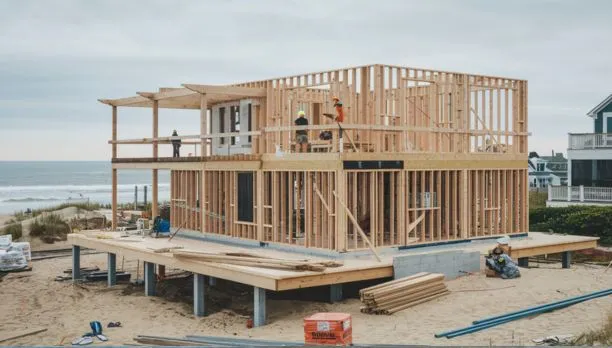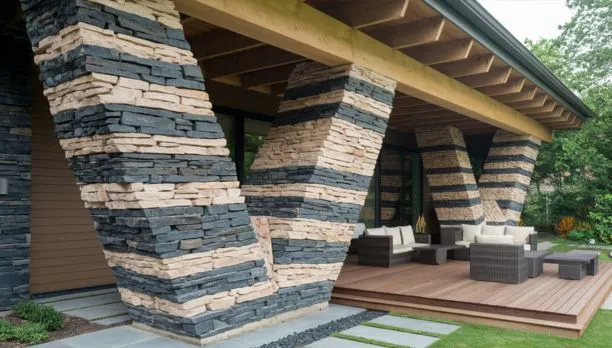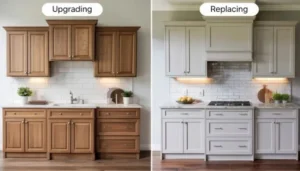How much does it cost to build a beach home in California? This is a common question for those dreaming of coastal living. With its stunning ocean views, mild climate, and vibrant communities, California’s beachfront properties are highly desirable. However, the cost of building a beach home can vary significantly based on location, materials, and design choices.
At Poseidon Remodeling, we understand the complexities of coastal construction. From securing permits to selecting weather-resistant materials, every step impacts the overall cost. Whether you’re planning a custom-built retreat or a modern getaway, knowing the financial aspects upfront is essential for making informed decisions.
Average Cost to Build a Beach House in California

If you’re wondering, how much does it cost to build a beach home in California, the answer depends on several factors, including location, materials, and labor. On average, the cost to build a California beach home ranges between $400 to $1,500 per square foot, with luxury homes exceeding this range due to high-end finishes and custom features.
Cost Variations by Coastal Region
The cost of building a beach home varies across California’s coastal cities. For example:
- San Diego – More affordable than other high-end locations, with costs starting around $400–$800 per square foot.
- Malibu – Known for its luxury properties, costs often exceed $1,000 per square foot, especially for oceanfront estates.
- Santa Barbara – Falls between San Diego and Malibu, with construction costs typically ranging from $600–$1,200 per square foot.
- Orange County (Laguna Beach, Newport Beach) – Costs can range between $700–$1,500 per square foot, depending on customization.
Breakdown of Major Cost Components
Building a California beach home involves several cost factors, including:
- Land Acquisition – Beachfront property prices vary significantly, with land alone costing millions in premium areas.
- Materials – Weather-resistant materials, such as stainless steel fixtures and impact-resistant glass, increase costs but are necessary for durability.
- Labor – Skilled labor in California is expensive, contributing to high construction costs.
- Permits & Regulations – Coastal Commission permits, environmental regulations, and zoning approvals add to the total budget.
At Poseidon Remodeling, we specialize in building and remodeling beach homes, ensuring durability and cost-efficiency. Understanding these cost factors helps homeowners plan better and avoid unexpected expenses when creating their dream coastal retreat.
Factors Affecting the Cost of Building a Beach House

When considering how much does it cost to build a beach home in California, it’s important to understand the various factors that influence the total price. From land prices to construction materials, several elements contribute to the overall cost. Working with an experienced beach house builder can help navigate these challenges and ensure a smooth construction process.
1. Location & Land Costs
The price of land plays a major role in the total cost of building a beach home. Properties directly on the waterfront are significantly more expensive than those set slightly inland. Highly desirable areas like Malibu and Laguna Beach command premium prices, while locations in less crowded coastal towns may offer more affordable options. Additionally, zoning laws and environmental restrictions in certain regions can impact what and where you can build.
2. Foundation & Structural Considerations
Building on the coast comes with unique challenges, especially when it comes to the foundation. Beach homes often require elevated foundations to protect against flooding and high tides. Piling foundations, which elevate homes above potential flood levels, can be costly but are necessary for long-term durability. Seismic reinforcements may also be required in earthquake-prone areas, adding to structural costs.
3. Building Materials
Due to the salty air, high humidity, and potential for extreme weather, a beach house builder must use high-quality, weather-resistant materials. Corrosion-resistant metal, impact-resistant glass, and moisture-resistant wood are essential to ensure longevity. These specialized materials cost more upfront but help reduce maintenance expenses over time.
4. Labor Costs
California has some of the highest labor costs in the country. Skilled electricians, and plumbers are in high demand, particularly for coastal construction projects that require expertise in specialized materials and techniques. Labor rates can vary depending on the location, with urban coastal areas generally having higher costs than more remote beach towns.
5. Permit & Regulatory Costs
Before starting construction, obtaining the necessary permits is essential. Coastal properties are subject to strict regulations from the California Coastal Commission, local zoning laws, and environmental impact assessments. Permit costs can add thousands to the overall budget, and delays in the approval process may extend the timeline of the project.
At Poseidon Remodeling, we specialize in home improvements and custom beach home construction, ensuring that every aspect from foundation to finishing touches is handled with expertise. By understanding these cost factors, homeowners can better plan their dream coastal retreat while staying within budget.
Coastal Features and Their Impact on Costs

When asking, how much does it cost to build a beach home in California, homeowners must consider the unique coastal features that affect construction costs. The environment near the ocean requires specialized building techniques and materials to ensure durability and resilience. From foundation choices to energy-efficient upgrades, each decision impacts the final budget.
1. Foundation Types: Pier vs. Slab Foundations
The foundation of a beach home plays a critical role in protecting it from flooding, shifting sands, and coastal erosion. There are two primary options:
- Pier Foundations – These involve raising the home on stilts, allowing water to flow underneath in case of high tides or storms. While more expensive, they provide better flood resistance and longevity.
- Slab Foundations – Less costly upfront but not ideal for flood-prone areas. They require additional waterproofing measures to prevent damage from moisture and shifting ground.
In most California coastal areas, pier foundations are preferred due to strict building regulations and the need for flood protection, increasing overall construction expenses.
2. Weatherproofing Needs: Saltwater Resistance & Storm Protection
The salty ocean air can accelerate wear and tear on a beach home, making weatherproofing essential. Special materials like corrosion-resistant metal, fiberglass doors, and vinyl window frames help prevent rust and decay. Additionally, homes in coastal regions may require:
- Impact-resistant windows to withstand high winds and flying debris.
- Waterproof sealants to protect exterior walls from humidity and salt damage.
- Hurricane/tidal wave protections, such as reinforced roofing and storm shutters, especially in high-risk areas.
These features add to the overall cost but are necessary for long-term durability and reduced maintenance.
3. Energy Efficiency Requirements: Solar Panels & High-Efficiency HVAC
California’s coastal climate provides an opportunity to integrate energy-efficient solutions into a beach home. Many homeowners opt for:
- Solar Panels – Utilizing abundant sunlight to lower electricity costs.
- High-Efficiency HVAC Systems – Designed to handle humid, salty air while maintaining indoor comfort.
- Smart Home Features – Automated blinds, energy-saving lighting, and advanced insulation to reduce energy consumption.
While these upgrades increase upfront costs, they offer long-term savings and improve sustainability.
At Poseidon Remodeling, we ensure every home is built with quality and functionality in mind. Whether selecting the right foundation or incorporating coastal kitchen ideas, our team focuses on durability and style, helping homeowners create the perfect oceanfront retreat.
Custom Exterior Features

When determining how much does it cost to build a beach home in California, exterior features are a major factor. A well-designed beach house includes durable outdoor spaces, resilient landscaping, and weather-resistant windows and doors to withstand the coastal environment.
1. Outdoor Living Spaces – Decks, Patios, Infinity Pools & Fire Pits
Beachfront homes emphasize outdoor living, making features like decks, patios, and pools essential. Many homeowners choose:
- Composite or marine-grade wood decks to resist moisture and salt exposure.
- Infinity pools for luxury and seamless ocean views, though they come with higher maintenance costs.
- Fire pits and outdoor kitchens, using rust-proof materials for longevity in the salty air.
These additions elevate the coastal lifestyle but require extra investment in durable materials.
2. Landscaping Costs – Drought-Resistant Plants & Sand-Resistant Designs
A beach house needs landscaping that can withstand wind, sand, and salt exposure. Popular choices include:
- Drought-resistant plants like succulents, native grasses, and palm trees that require minimal water.
- Sand-resistant hardscaping, such as stone pathways and raised garden beds to prevent erosion.
- Smart irrigation systems that use minimal water while keeping plants healthy.
While these features reduce upkeep, initial installation costs can vary depending on the design.
3. Windows & Doors – Impact-Resistant Glass & Corrosion-Proof Frames
Windows and doors are critical for protecting a beach house from storms and salty air. High-quality options include:
- Impact-resistant glass to withstand high winds and flying debris.
- Aluminum or vinyl frames, which resist rust and warping better than wood.
- Large sliding glass doors that offer stunning ocean views while ensuring durability.
Investing in durable windows and doors helps lower maintenance and energy costs in the long run.
At Poseidon Remodeling, we specialize in exterior home remodel solutions, ensuring your beach home is both stylish and built to last in California’s coastal climate.
Additional Cost Considerations
When evaluating how much does it cost to build a beach home in California, it’s important to look beyond construction expenses. Insurance, maintenance, and utilities all contribute to the long-term costs of owning a beach house. Proper planning ensures homeowners are prepared for these ongoing financial commitments.
1. Insurance Costs: Flood & Windstorm Coverage
Beachfront properties often require specialized insurance due to their exposure to natural elements. Standard homeowners’ insurance isn’t enough, so owners must invest in:
- Flood Insurance – Required in many coastal zones, especially in FEMA-designated floodplains.
- Windstorm Coverage – Protects against hurricane-force winds and storm damage, often at a high premium.
- General Home Insurance – More expensive for beach homes due to increased risks of moisture damage and erosion.
These policies can significantly increase annual homeownership costs.
2. Maintenance & Repairs: Long-Term Upkeep Expenses
A beach house faces constant exposure to salt air, humidity, and high winds, which accelerate wear and tear. Homeowners should budget for:
- Frequent exterior painting and sealing to prevent salt corrosion.
- Roof inspections and repairs due to strong coastal winds.
- HVAC maintenance, as salty air can cause damage to heating and cooling systems.
Regular upkeep is essential to extend the life of a beach home and avoid costly repairs.
3. Utility & Infrastructure Expenses: Remote Area Challenges
Some beach properties, especially in less developed areas, have higher utility and infrastructure costs, including:
- Well Water & Septic Systems – If city water and sewer lines aren’t available, installation and maintenance of private systems add to expenses.
- Electric & Internet Access – Remote locations may require costly installation of power lines or satellite internet services.
- Stormwater Drainage Solutions – Necessary to prevent flooding and soil erosion, often requiring additional investment.
Understanding these costs helps homeowners budget effectively when planning a whole home remodel where to start or building a new beach property.
At Poseidon Remodeling, we help clients navigate these additional expenses, ensuring their beach home is built for long-term comfort and sustainability.
Comparing Building a Beach House vs. Renovating
For those wondering how much does it cost to build a beach home in California, a key decision is whether to build from scratch or renovate an existing property. Both options have advantages and drawbacks, and the best choice depends on budget, location, and long-term goals.
1. Pros and Cons of New Construction
Building a new beach home allows for complete customization but comes with higher upfront costs.
Pros:
- Full Customization – Choose the layout, materials, and features customized to your needs.
- Modern Building Standards – New construction meets updated safety, energy, and coastal building codes.
- Long-Term Durability – Using weather-resistant materials reduces maintenance costs.
Cons:
- Higher Initial Costs – Land purchase, permits, and construction add up quickly.
- Longer Timeline – New builds take months or even years to complete.
- Regulatory Hurdles – Coastal Commission approvals and zoning laws can delay projects.
2. Pros and Cons of Renovation
Renovating an existing home can be more cost-effective, but unexpected structural issues may arise.
Pros:
- Lower Overall Costs – Renovations are often cheaper than building from the ground up.
- Faster Completion – Remodeling takes less time than a full-scale construction project.
- Preserving Character – Older beach homes have unique architectural charm.
Cons:
- Hidden Structural Problems – Older homes may have foundation or moisture damage.
- Limited Customization – You may have to work within the existing layout.
- Permit Challenges – Renovating in coastal zones still requires regulatory approvals.
3. Which Option is Better?
The best choice depends on the home’s condition and your goals. If an existing cost of a beach home requires extensive repairs, building new may be the better long-term investment. However, if the structure is sound, a well-planned renovation can save money while improving functionality.
At Poseidon Remodeling, we specialize in both new construction and renovations, offering expert guidance on home addition ideas to help homeowners achieve their dream beach house.
Final Thought
When asking how much does it cost to build a beach home in California, homeowners must consider land prices, construction materials, labor, permits, and long-term expenses like insurance and maintenance. Whether building from the ground up or renovating an existing property, careful budgeting and planning are essential to avoid unexpected costs. Choosing weather-resistant materials and energy-efficient designs can also help reduce future maintenance expenses.
At Poseidon Remodeling, we specialize in crafting high-quality beach homes that blend durability with style. Our expert team ensures every project meets coastal regulations while staying within budget. Contact us today for a consultation and get a personalized estimate for your dream beach home!
FAQs
How much does it cost to build a beach home in California per square foot?
The cost varies based on location, materials, and design, but on average, building a beach home in California ranges from $400 to $1,200 per square foot, with luxury homes exceeding this range.
What factors influence the total cost of a beach home in California?
Major cost factors include land prices, permits, labor, materials, coastal foundation requirements, and weatherproofing features like impact-resistant windows and salt-resistant materials.
Is it cheaper to build a beach home or renovate an existing one?
Renovating can be more affordable if the home has a solid foundation, but building new allows for modern designs and compliance with updated building codes. The right choice depends on the home’s condition and your long-term goals.
Are there extra costs for building near the California coast?
Yes, additional expenses include Coastal Commission permits, flood insurance, foundation reinforcements, and corrosion-resistant materials to withstand harsh coastal conditions.
How can I budget effectively for building a beach home?
Work with experienced professionals like Poseidon Remodeling to get accurate cost estimates, choose durable materials, and plan for long-term maintenance to ensure a cost-effective and well-built beach home.










